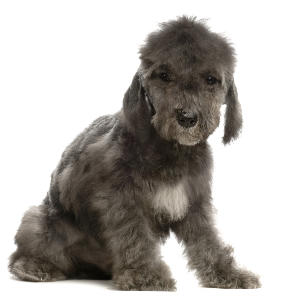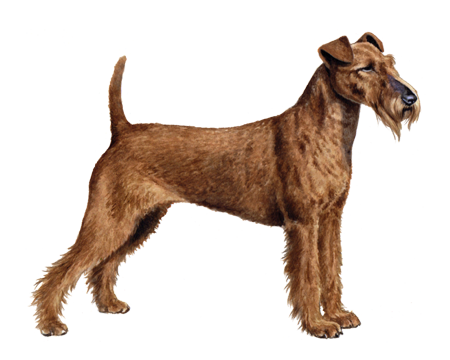
Bedlington Terrier
Bedlington Terriers are fantastic family pets; they love kids and are ready, willing, and able to play with them, but they also love to relax and curl up with you at the end of a long day. They are a highly social breed, and their intelligent and extroverted personality makes them just another member of the family.
Interested in discovering if your dog is a Bedlington Terrier?
Check out Wisdom Panel's DNA tests.

Bedlington Terrier Traits
General Appearance
Part of the Bedlington Terrier’s irresistible charm lies in its look; according to some, a Bedlington Terrier looks similar to a sheep. The breed has a crisp, delightfully curly coat, which along with their tasseled ears and fleecy head, are endearing traits distinct to this breed.They are graceful and well balanced, with a coat that can come in multiple colors.
Coat and Coloring
The Bedlington Terrier has a distinct coat that’s both hard and soft, crisp but not wiry, and curly, particularly near the head and face. They can be blue, sandy, liver, blue and tan, sandy and tan, or liver and tan.
Distinctive Physical Traits
You’ll know a Bedlington Terrier from their sheep-like appearance. Their crisp and curly coat can come in multiple colors, and their head is covered with a striking topknot that tends to be slightly lighter in color than the rest of the body.
Bedlington Terrier Temperament
Playful and exuberant, friendly, intelligent, and entertaining, the Bedlington Terrier makes a terrific family pet.
Bedlington Terriers are eager to please—so they tend to be pretty easy to train—and enjoy spending time with their people.


Bedlington Terrier History
The Bedlington Terrier has a unique history—it’s the oldest unbroken pedigree dating back to 1782. Though records from the 1700s are spotty, the Bedlington breed likely originated from a mixture of Otterhounds, Whippets, Poodles, and Bull Terriers. The dogs rose from hunting in coal mines and started becoming more common in the manor houses of the British elite.The first dog identified as a Bedlington Terrier, Piper, was bred in 1825. The Bedlington Terrier has roots in hunting for multiple types of prey—including rabbits, rats, fox, and even otter, thanks to their swimming skills.
These days, the Bedlington Terriers are still excellent hunters, but because of their charm and loving nature, they also make great house pets.
Bedlington Terrier Care
Nutrition
The Bedlington Terrier is an active breed that does best with high-quality dog food that’s suited to their particular age, as well as any additional health concerns.
As with any dog, it’s important to monitor the amount of food and treats that you give your Bedlington Terrier, especially since some dogs may be prone to gaining weight as they age. Your veterinarian is always a good source to help provide you with appropriate nutrition and feeding guidelines.
Grooming
The quintessential curly coat on the Bedlington Terrier rarely sheds, but it does grow quickly and will need to be cut or clipped every two months or so. Besides a haircut, this breed needs a brush once or twice a week to keep their coat healthy.
All dogs require regular dental care, cincluding at-home teeth brushing and professional dental cleanings, and the Bedlington Terrier is no exception. Maintaining good dental hygiene is important for their overall long-term health.
Exercise
True to their terrier roots, the Bedlington Terrier is an energetic breed that requires a lot of exercise to stay happy and healthy. The breed loves to be with its people, so it enjoys walks, runs, or a game of fetch in a (fenced in) yard. Because of their hunting background and ease of training, they make great candidates for dog sports like agility and tracking.
Training
A Bedlington can be, like most terriers, stubborn and independent. But they are also smart and eager to please, so they respond well to regular, positive training.

Bedlington Terrier Genetic Health Conditions
-
Chondrodystrophy (CDDY) and Intervertebral Disc Disease (IVDD) Risk
Chondrodystrophy (CDDY) is a skeletal disorder characterized by shortened limbs and abnormal early degeneration of the spinal discs, or intervertebral disc disease (IVDD), which predisposes to disc herniation.
Knowing if your Bedlington Terrier is a carrier or at-risk for these conditions can help you and your veterinarian plan for your pup’s lifelong care. With Wisdom Panel™ Premium, you can get results for over 200 genetic health tests.
Breed Group
Terrier
The Terrier Group ancestors were bred to hunt and kill vermin. They are often characterized as feisty and energetic dogs whose sizes range from fairly small to much larger.
































































